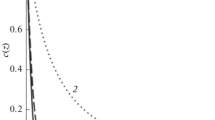Abstract
The work of the positive electrode (cathode) of a lithium-ion battery is simulated. The model of equally sized grains of three types: the intercalating agent grains with a volume fraction g, the electrolyte grains with a volume fraction g i, and the carbon black grains with a volume fraction g e is studied. The optimal composition of cathode active mass providing maximum specific capacity of cathode is determined. It is shown that a fraction of carbon black grains should be as small as possible: g e = 0.35. The variation in the fraction of intercalating agent grains within the allowable limits (0 ≤ g ≤ 0.3) changes the main parameters of cathode active mass: a fraction of electrochemically active intercalating agent grains g* (g* < g); a specific surface area S, on which the electrochemical process proceeds; and the conductivity k* by lithium ions in the ionic percolation cluster, which forms in the cathode active mass. The parameters g* and S decrease and parameter k* steeply increases with decreasing g. Therefore, in the range of possible values of g, specific capacity of cathode reaches the maximum value at g = g opt. The value of g opt is determined under the galvanostatic mode of cathode discharge. The cathode working parameters: the active layer thickness, discharge time, specific capacity, and potential at the cathode active layer/interelectrode space interface at the instant of discharge completion are calculated in relation to a fraction of intercalating agent grains g.
Similar content being viewed by others
References
Chirkov, Yu.G., Rostokin, V.I., and Skundin, A.M., Russ. J. Electrochem., 2011, vol. 47, p. 59.
Tarasevich, Yu.Yu., Perkolyatsiya: teoriya, prilozheniya, algoritmy (Percolation: Theory, Applications, Algorithms), Moscow: Editorial URSS, 2001.
Chirkov, Yu.G. and Rostokin, V.I., Russ. J. Electrochem., 2003, vol. 39, p. 622.
Chirkov, Yu.G., Russ. J. Electrochem., 1999, vol. 35, p. 1281.
Chirkov, Yu.G., Rostokin, V.I., and Skundin, A.M., Russ. J. Electrochem., 2011, vol. 47, p. 71
Skundin, A.M., Efimov, O.N., and Yarmolenko, O.V., Usp. Khim., 2002, vol. 71, p. 378.
Chirkov, Yu.G. and Rostokin, V.I., Russ. J. Electrochem., 2006, vol. 42, p. 715.
Botte, G.G., Johnson, B.A., and White, R.E., J. Electrochem. Soc., 1999, vol. 146, p. 914.
Costamagna, P. and Srinivasan, S. J. Power Sources, 2001, vol. 102, p. 242.
Author information
Authors and Affiliations
Corresponding author
Additional information
Original Russian Text © Yu.G. Chirkov, V.I. Rostokin, A.M. Skundin, 2012, published in Elektrokhimiya, 2012, Vol. 48, No. 9, pp. 981–991.
Rights and permissions
About this article
Cite this article
Chirkov, Y.G., Rostokin, V.I. & Skundin, A.M. Computer simulation of positive electrode operation in lithium-ion battery: Optimization of active mass composition. Russ J Electrochem 48, 895–904 (2012). https://doi.org/10.1134/S1023193512040052
Received:
Published:
Issue Date:
DOI: https://doi.org/10.1134/S1023193512040052



